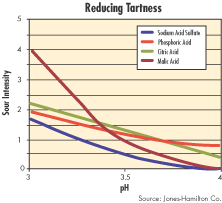
To address this issue, Jones-Hamilton Co. (Waldbridge, Ohio) has introduced a new acidulant, pHase™. It is self-affirmed GRAS in the U.S. at levels that meet good manufacturing practices and is on the European Directive for miscellaneous additives, allowing for its general use in foods.
pHase is a dry granular acid that easily dissolves in water. Its generic name is sodium acid sulfate, and its chemical formula is NaHSO4. In a water solution, it readily dissociates into sodium ions, hydrogen ions and sulfate ions. The sodium ion contributes to flavor enhancement and bitter masking, the hydrogen ion lowers pH and the sulfate ion is an essential electrolyte required for good health.
An independent service, Sensory Spectrum (Chatham, N.J.), assessed the sour intensity of pHase, citric acid, malic acid, and phosphoric acid in water at three different pH values. The panelists evaluated the samples to rate the perceived sour intensity of each acid at pH 3.0, 3.5, and 4.0. (See chart on this page.)
pHase has the lowest level of sour taste when used to control pH; therefore, the “warm,” “brown” flavors work well with this acid when pH control is necessary. These flavors include banana, chocolate, coconut, cola, coffee, mocha, tea, toffee and vanilla.
Intense sweeteners have sensory profiles often described as having a delayed impact and lacking mouthfeel and body, while their negative aftertastes are described as bitter, astringent and having a lingering sweetness. pHase can reduce these negative tastes, according to its manufacturer. It improves impact, adds body and mouthfeel and reduces aftertastes. Its acid profile means a softer taste carries and rounds out the sweetness peak of the intense sweeteners, and generates more body and mouthfeel.

pHase has its own unique sensory and performance characteristics. Research to date has shown these characteristics can be advantageous in a wide variety of food and drink systems:
- Truer flavor character in acidity-controlled products such as chocolate, vanilla, coconut, coffee, caramel, teas and nuts.
- Softer, rounder taste profile, giving juicier, riper fruit flavors in non-citrus products.
- Greater flexibility in the formulation of intense sweeteners.
- Ingredient cost reduction.
David Morgan at 888-858-4425dmorgan@jones-hamilton.com
www.jones-hamilton.com
Jones-Hamilton Co., Specialty Products Division
Write in 401


